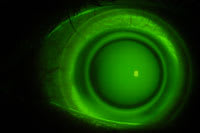prescribing
for astigmatism
The
Hybrid Lens Re-Emerges
BY
PETER D. BERGENSKE, OD, FAAO
he combination of rigid lens optics and soft lens comfort has long been a quest of contact lens technology. We've seen several permutations of the concept of a hybrid lens, namely the Saturn (II) and the SoftPerm lenses (CIBA Vision), which combined a rigid center with a soft "skirt." Unfortunately, the promise has never been adequately fulfilled. These early hybrids suffered from limitations in fit, physiology and optics, not to mention difficulties in durability and handling.
More recently we've seen the reintroduction of this concept in the SynergEyes lens (SynergEyes, Inc.), which has taken advantage of modern rigid lens technology and an improved process for melding the two materials. It also benefits from some serious efforts to determine the best way to fit this quirky, yet useful, lens.
The SynergEyes lens makes use of the Paragon HDS 100 material for the center, optical portion of the lens, which is available in a standard 8.4mm diameter and radii from 7.10mm to 8.20mm in 0.10mm increments. Center thickness is adequate to prevent significant flexure. The soft skirt is currently a low-water-content (27 percent) non-ionic low-Dk material. Overall lens diameter is standard at 14.5mm. Rumor of a high-Dk silicone hydrogel skirt has been no more than just that so far, although it would be an obvious improvement in the future.
General Fitting Guidelines
|
|
|
Figure 1. Fluorescein pattern demonstrates desired apical clearance. |
Extensive fitting trials for the SynergEyes lens were conducted at Pacific University. These trials led to the standard recommendation that the central optic should be 0.3mm, or about 1.25D, steeper than flat K. It's imperative that you fit the central optic with central clearance, or the lens will tighten with wear, leading to an immobile, uncomfortable lens.
You can best confirm apical clearance by use of high molecular weight fluorescein. The ideal pattern yields central clearance with no significant bubble formation.
Skirt radii are 0.7mm to 1.6mm flatter than the central radius, in 0.3mm steps. Choose the initial skirt radius based on the horizontal visible iris diameter (HVID). For most eyes the skirt radius will be flatter than the central optics by 1.0mm (for larger HVIDs) or 1.3mm (for smaller HVIDs). Choose the more extreme skirt radii in the event that trial fitting with the indicated skirt radius demonstrates a need for greater or less sagittal depth.
Determining the Final Lens
Currently the SynergEyes lens is available in its series "A," which is intended for most eyes. Special designs for keratoconus and post-refractive surgery are on the way.
The fitting set consists of 12 base curves in each of the two standard skirt radii. A fitting calculator is available that takes keratometer and HVID measurements into account to determine an initial lens.
For eyes with regular astigmatism it's possible to empirically determine the initial lens based on calculation. For irregular astigmatism, you must employ a trial lens. If the calculator calls for the 0.7mm or 1.6mm flatter skirt radius, try the closer of the two standard skirts. Conjunctival impingement indicates need for a flatter skirt, and edge fluting indicates need for a steeper skirt.
Dr. Bergenske, a past chair of the American Academy of Optometry's Section on Cornea and Contact Lenses, has practiced for over 20 years in Wisconsin and now is on the faculty at Pacific University College of Optometry. E-mail him at: berg1101@pacificu.edu.




